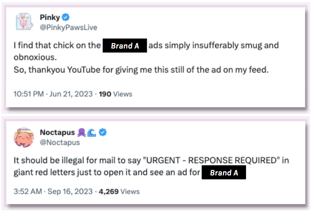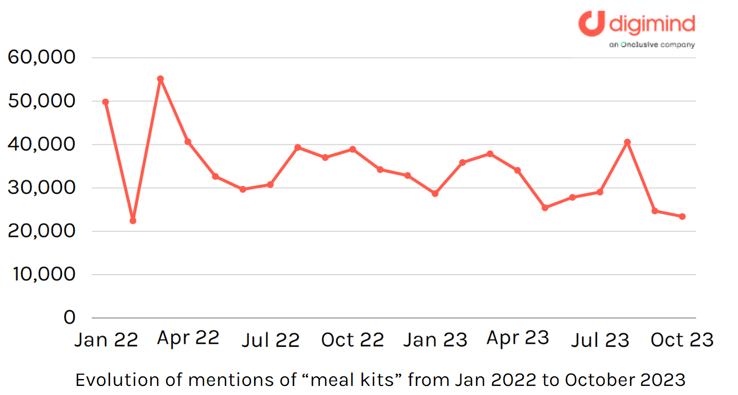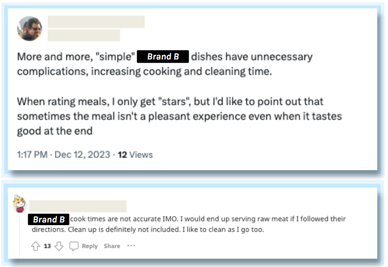Data Driven Delights: Decoding Consumer Sentiments in the Meal Kit Market
The dynamics of the meal kit industry underwent a profound transformation during the peak of the COVID-19 pandemic. Consumers, confined to their homes, found solace in the idea of preparing restaurant-quality meals without venturing into public spaces. This trend, fueled by the desire for both safety and a culinary experience, contributed to the rapid growth of meal kit subscriptions.
However, as the global situation has gradually improved, and societies have started to regain a semblance of normalcy, a noticeable deceleration in the enthusiasm for at-home meals has become apparent.
.jpg?width=570&height=380&name=pexels-vanessa-loring-5971871%20(1).jpg)
Despite the initial allure of culinary experimentation and the convenience offered by meal kits during the pandemic, the sustainability of this demand has proven challenging. As individuals gradually returned to their pre-pandemic routines, the practicality and cost-effectiveness of meal kits came under scrutiny. The three-year span since the onset of the pandemic has allowed consumers to reassess their priorities, with many opting for more economical alternatives as they navigate the economic uncertainties brought on by the escalating inflationary pressures affecting various food categories.
The economic reality is that the rising prices associated with meal kit subscriptions, which were already positioned at a premium, have emerged as a significant deterrent for consumers, prompting them to reconsider and curtail their reliance on such services.
Optimistic Outlook
Interestingly the broader outlook for the meal kit industry remains optimistic. The global market reached an impressive value of $4.732 billion, indicating that, despite the slowdown, there continues to be a significant market for this convenient culinary solution. What adds further credence to the positive outlook is the projected compound annual growth rate (CAGR) of 16.85% during the forecast period. These projections foresee a substantial expansion of the meal kit market, with an anticipated value of $12.048 billion by 2027.
Digimind's Findings
The Mini Report conducted by Digimind presents a noteworthy observation: a decline in the popularity of meal kit mentions in social listening data.
Social listening data provides valuable insights into the sentiments and discussions surrounding a particular topic, in this case, meal kits. The decline in mentions suggests a shift in consumer interest or engagement with meal kit services. This shift could be influenced by various factors, including changing consumer preferences, evolving market dynamics, or external economic factors.
This finding raises concerns and challenges the anticipated value and sustained growth of the meal kit industry. Understanding the reasons behind this decline is crucial for businesses operating in the meal kit industry. It prompts a closer examination of consumer feedback, market trends, and potential challenges faced by meal kit providers.
Apart from cost-related concerns, meal kit brands encounter various challenges that impact their overall performance and subscriber satisfaction. Two notable challenges identified in the Mini Report by Digimind are:
#1: Ad Fatigue
A screenshot of Brand A's advertisement
The challenges faced by a brand studied (Brand A), revolve around the issue of "over advertising," contributing to a phenomenon known as ad fatigue. Ad fatigue occurs when consumers are exposed to an excessive number of advertisements from a particular brand, leading to negative sentiments and feelings of annoyance among the target audience.
The key observations related to Brand A's advertising challenges are as follows:
a) Excessive Advertising Exposure:
Brand A has inundated its audience with a high frequency of advertisements, potentially saturating various marketing channels. This abundance of exposure can result in diminishing returns and, in some cases, a backlash from consumers who perceive the brand as overly intrusive.
b) Negative Consumer Sentiment:
The consequence of over-advertising for Brand A is reflected in the negative sentiments expressed by consumers. The study indicates that a significant portion of discussions (50.6% of total mentions) about Brand A are centered around consumer dissatisfaction with the brand's advertisements. This negative sentiment can influence overall brand perception and impact consumer trust, potentially leading to a decline in brand loyalty and engagement.
Addressing these challenges requires a strategic reassessment of Brand A's advertising approach.
This may involve diversifying marketing channels, optimizing ad frequency, and incorporating more targeted and personalized advertising strategies. Striking a balance between maintaining visibility and avoiding excessive advertising is essential to prevent ad fatigue and cultivate a positive brand image. Additionally, actively listening to consumer feedback and adapting advertising strategies accordingly can help mitigate the negative impact of over-advertising on brand perception.
#2: Perceived Complexity
The challenges faced by a second brand (Brand B), as identified in the Digimind study, revolve around perceived complexity in the meal preparation process, leading to consumer dissatisfaction. The key points related to Brand B's challenges are as follows:
a) Perceived Complexity:
Consumers of Brand B have expressed concerns about the perceived complexity involved in preparing meals from their meal kits. This complexity may involve additional cooking and cleaning time, creating a sense of inconvenience for consumers.
b) Impact on Overall Experience:
Consumers' enjoyment of a delicious meal is overshadowed by the challenges they face during preparation.
Necessity for Improvement:
The shared consensus among Brand B's consumers emphasizes that, beyond the taste of the meals, there is a critical need to improve the ease of preparation and overall convenience. This recognition calls for a strategic reassessment to prioritize a seamless and efficient cooking experience that aligns with the brand's promises.
Addressing these challenges requires a strategic focus on improving the user experience throughout the meal kit journey, from unboxing to the final dish. This strategic reassessment aligns with the evolving consumer expectations for not just delicious meals but also hassle-free and convenient cooking experiences. By prioritizing these aspects, Brand B can enhance customer satisfaction and loyalty and differentiate itself in a competitive market.
Next Steps
Onclusive Social (formerly Digimind)'s robust social listening capabilities offer a strategic advantage for marketing and communication professionals seeking to propel their businesses forward. In the context of individual brand considerations within the meal kit industry,
Digimind's social listening goes beyond mere brand monitoring. It extends to the vigilant observation of competitor activities, allowing brands to benchmark themselves against industry standards. This comprehensive approach enables businesses to identify areas for improvement, adapt to changing consumer preferences, and maintain a competitive edge in a market that is evolving rapidly.
By leveraging Digimind's capabilities, marketing and communication professionals can make informed decisions that positively impact both brand perception and market positioning within the dynamic landscape of your industry.




